Hip discomfort is a widespread health issue in the modern world. If you are experiencing Chevy Chase hip pain, it is essential that you not ignore the problem. The hip joint comprises two orthogonal axes that allow for flexion and extension and internal and exterior rotation. The hip is a powerful and versatile joint that bears weight and facilitates movement. What goes through your mind when you have hip pain?
The first stage in hip recovery is obtaining accurate information and rejecting misconceptions. Hopefully, after reading this article, you will be able to make an informed decision about how to treat your hip discomfort.
Unlike the elderly, young people seldom have hip discomfort
Injuries to the hip may occur at any age. Some athletes in their twenties and thirties battle with overuse injuries, and it is frequent in young people who have had childhood disorders like Perthes disease or dysplasia. Hip degeneration is common in patients between the ages of 30 and 50. Patients over 50 often have discomfort in the worn joints due to “bad hips.”
It is normal for older adults to have hip discomfort due to osteoarthritis or rheumatoid arthritis. On the other hand, hip pain in young people often results from a catastrophic injury like a vehicle accident or an overuse injury acquired while engaging in sports or other strenuous physical activity. As such, you can’t discredit the possibility of getting hip pain while still young.
It goes away with time
Many middle-aged amateur athletes believe this misconception when hip discomfort first appears. It is possible, but it might just be an excuse to delay therapy. People with this mentality adjust their routines, playing at a lower intensity or cutting out on activities altogether because of their hip discomfort. Some people may abandon their favorite sport for a whole season in favor of the elliptical or swimming. It may cause a gradual weakening of one’s physical capabilities.
Others attempt self-medication by addressing the pain signs alone. They might take several different over-the-counter pain relievers, see a chiropractor, or try acupuncture. Some of these fixes may help in the short term, but they may not get to the issue’s root. These methods should be integrated into a comprehensive plan that includes conventional medical care to be effective.
When you have hip discomfort, it is solely in your hips
Often, the source of hip discomfort is difficult to pinpoint. Pain in the hip region may manifest itself in various locations, including the thigh, groin, buttocks, and inside and outside of the hip joint. Hip pain is often vague and hard to localize. Numerous nerves and tissues in the body are linked to the hip joint and act in tandem with it. Contrary to popular belief, the hip joint is located more in the groin than on the side, and hip pain often mimics a groin strain because of its proximity to the area. Due to the path of the sciatic nerve, hip discomfort might be mistaken for back pain. See a professional if you are feeling any discomfort in the body, whether in the groin or the back.
Understanding the misconceptions and truths regarding hip pain is vital to establishing the best treatment strategy for you, whether you have already been diagnosed or are just starting your research.

